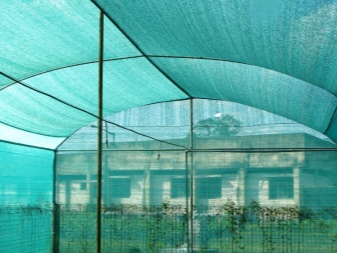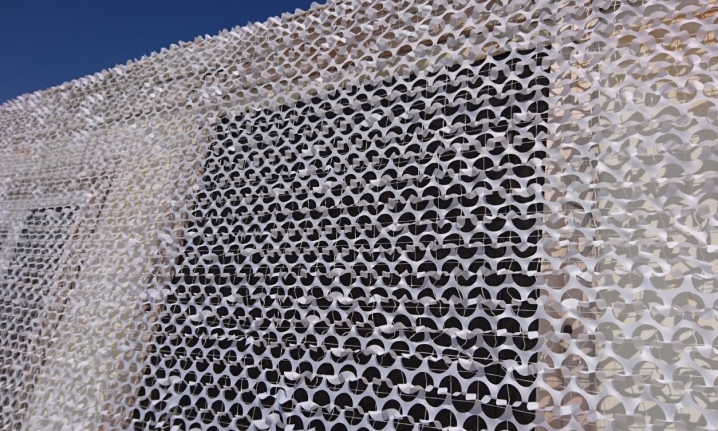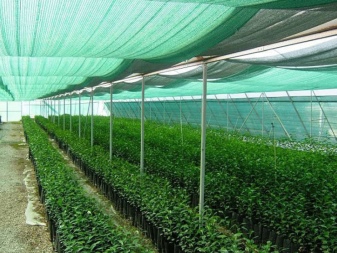Features of nets for canopies and their varieties

Meshes are a simple and practical solution for decorating awnings. They allow you to protect the fence, close the recreation area from the scorching sun, create a barrier for mosquitoes and other insects and hide the vehicle from prying eyes. The modern market offers a wide range of nets of different types - let's dwell on all the nuances of the choice.
Description and purpose
The net is a textile fabric made on a net basis, some models are supplemented with patches of film or fabric fixed on the base.
Grids have a number of advantages:
- resistance to temperature extremes;
- water-repellent characteristics;
- combustion resistance;
- silent swaying in the wind;
- lack of glare under the bright rays of the sun.
In addition, the materials from which the nets are made are not susceptible to mold and mildew damage. They do not rot over time and do not lose their colors as they are used.


A mesh-based shelter has a beneficial effect on plants - the canopy effectively protects against UV radiation. However, it does not give full shade - the sunlight is evenly distributed over the entire area. Garden crops in this mode fully grow and develop, the fruiting period increases, and the yield increases. At the same time, the mesh allows water to pass through, but protects the seedlings from hail and strong winds.
The grids are used for the installation of canopies for gazebos, terraces and other recreation areas. Light weight and compactness allow you to take the covering material with you to picnics, trips to the country and even to the beach. The material effectively protects from wind and rain, shelters from annoying mosquitoes, allows heat to pass through, but at the same time does not aggravate the heat under the canopy. There is no greenhouse effect when using this material.
And finally, the nets are used as a vertical canopy, stretching them along the boundaries of the site like a fence. Depending on the model, the degree of shading of such a shelter can vary from 35 to 90%.

Views
There are several main types of mesh.
- Camouflage Is a good solution for a gazebo. A camouflage net as a canopy allows you to create a comfortable seating area on hot days. It has pronounced shading properties, but at the same time maintains a comfortable level of light transmission. In open areas, camouflage nets are used to camouflage tents, boats, cars or motorcycles. Some models of nets are widely used in military affairs to camouflage special equipment, equipment and locations of manpower.

- To protect against annoying insects, mosquito nets are used. They are made of PVC-coated fiberglass or polyester, the cells can be small (1x1mm) or super-small (0.3x0.9 mm). This allows you to create a barrier not only for small insects, but also for plant pollen - this is especially important for allergy sufferers.


- Shading is considered an improved version of the mosquito net. In addition to protecting against mosquitoes and flies, it helps maintain a comfortable temperature under the canopy - it prevents the penetration of bright sunlight and protects against temperature extremes. Typically, such a mesh is made in dark blue or green shades, most often from nylon thread. Such products are particularly durable, wear-resistant and prevent sagging when pulled over wide objects.


- A chain-link mesh is sometimes used as shading. In this case, you need to start up a hedge of flowering vines along it. This option looks very decorative and at the same time effectively hides vacationers from prying eyes and protects from the scorching sun.

The meshes can be made from different materials.
- Polycarbonate - the most expensive, but at the same time the highest quality material. It is characterized by high strength and resistance to natural and climatic factors. Such a canvas has a long operational period and, after several years, retains its decorative appearance and functional properties.


- Polymers - are a cheap analogue of polycarbonate. Such material has a low price, but the quality of the products leaves much to be desired. Of course, it will protect from a light wind, but in general, its resistance to adverse natural factors is low. Such products serve no more than 2-3 seasons.

- Fabric is another budget option. Such nets are resistant to UV radiation, but under the influence of rain and snow they begin to rot and after a couple of months they can be safely thrown away.

When choosing a model for decorating a room, you can use cheap mesh options, but to create a reliable shelter, it is better to give preference to expensive polycarbonate.

Nuances of choice
The meshes may differ in their purpose. If you are equipping a canopy for horticultural crops, you should decide on the parameters of the density and light transmission of the material. There are several basic grades of mesh shading.
- 45% is a light version, such a grid transmits the sun's rays well and contributes to their uniform redistribution throughout the covering area. Such sheds are usually used for light-loving plants - melons, cucumbers, strawberries.
- 60% is a slightly denser canvas, transmits light, but protects from ultraviolet radiation. Suitable for vegetable crops - peppers, tomatoes, eggplants, cabbage.
- 70% are dense materials. These nets do not trap sunlight, but at the same time block the action of direct UV radiation. Usually used to cover greenhouses and greenhouses from the outside.
- 80% are rather dense nets that impede the passage of light and sunlight. Not recommended for use in gardens and vegetable gardens, as they can cause the death of the crop. Suitable for creating canopies over gazebos and car shelters.
- 90% - the maximum degree of protection, optimal for sheltering important objects. It is often found as a canopy on the summer verandas of cafes and restaurants.

When choosing a net for plant protection, an important factor in the selection is the color of the product.
- Red - stimulates plant growth, accelerates the process of flowering and ripening of fruits, increases the size of the crop. If we compare the growth of the same plant under nets of different shades, then the best indicators will be for crops under red shelter.

- Blue - such a grid, on the contrary, inhibits the growth of plants. Has a beneficial effect on the growth of green mass in lettuce, dill and parsley.

- Gray - causes branching of the central part of the plant, protects against low temperatures.

- Pearl - has a beneficial effect on horticultural crops, stimulates the growth of additional branches, increases the size of fruits and accelerates ripening.

All of these factors are important. If the wrong mesh is chosen, there is a risk of creating unnecessary shading and the death of crops. If you are camouflaging a car, tent or boat, there is always a chance that the object will be detected when choosing an insufficiently dense material.


How to choose a grid for shading vegetables, see the video.













The comment was sent successfully.